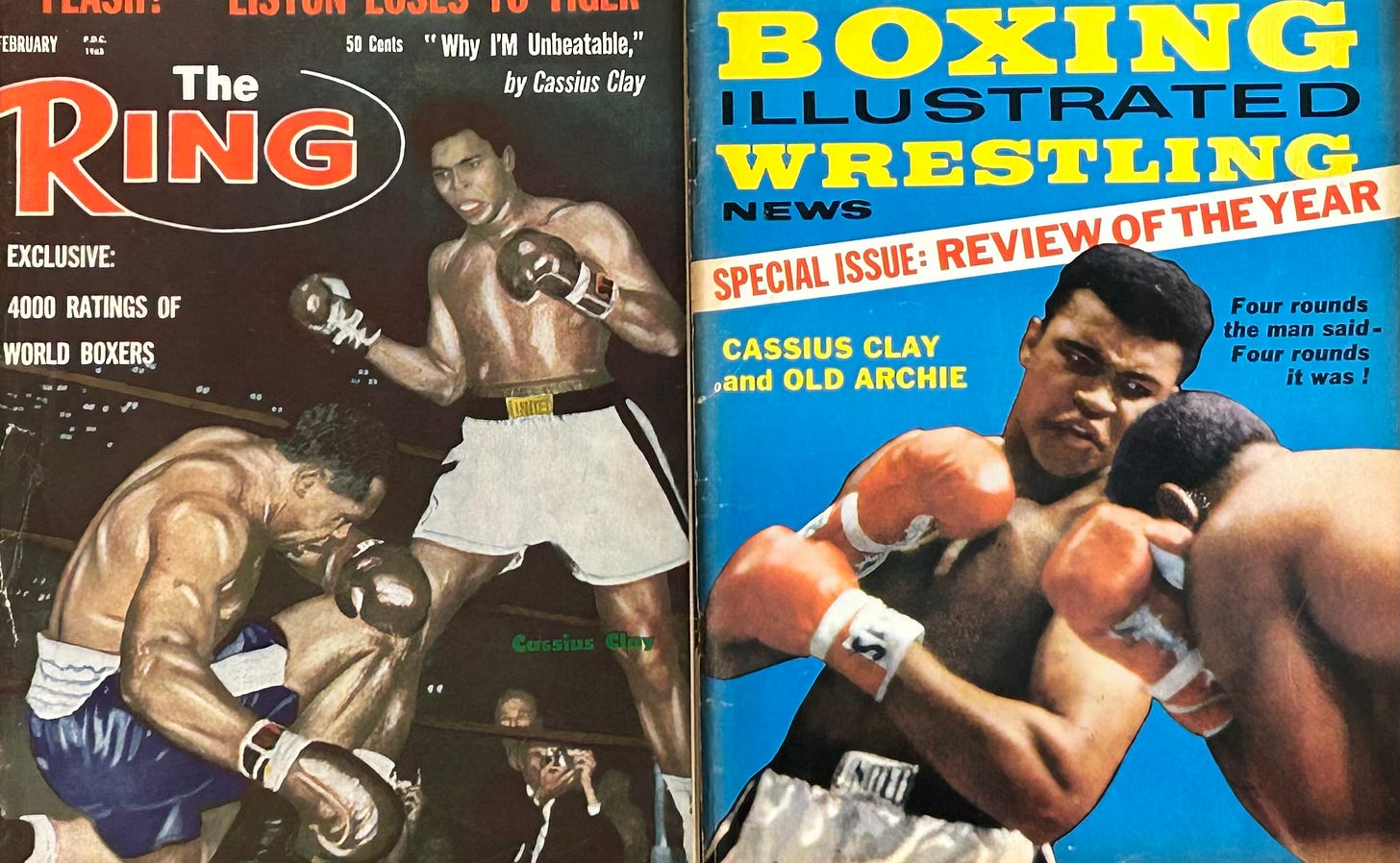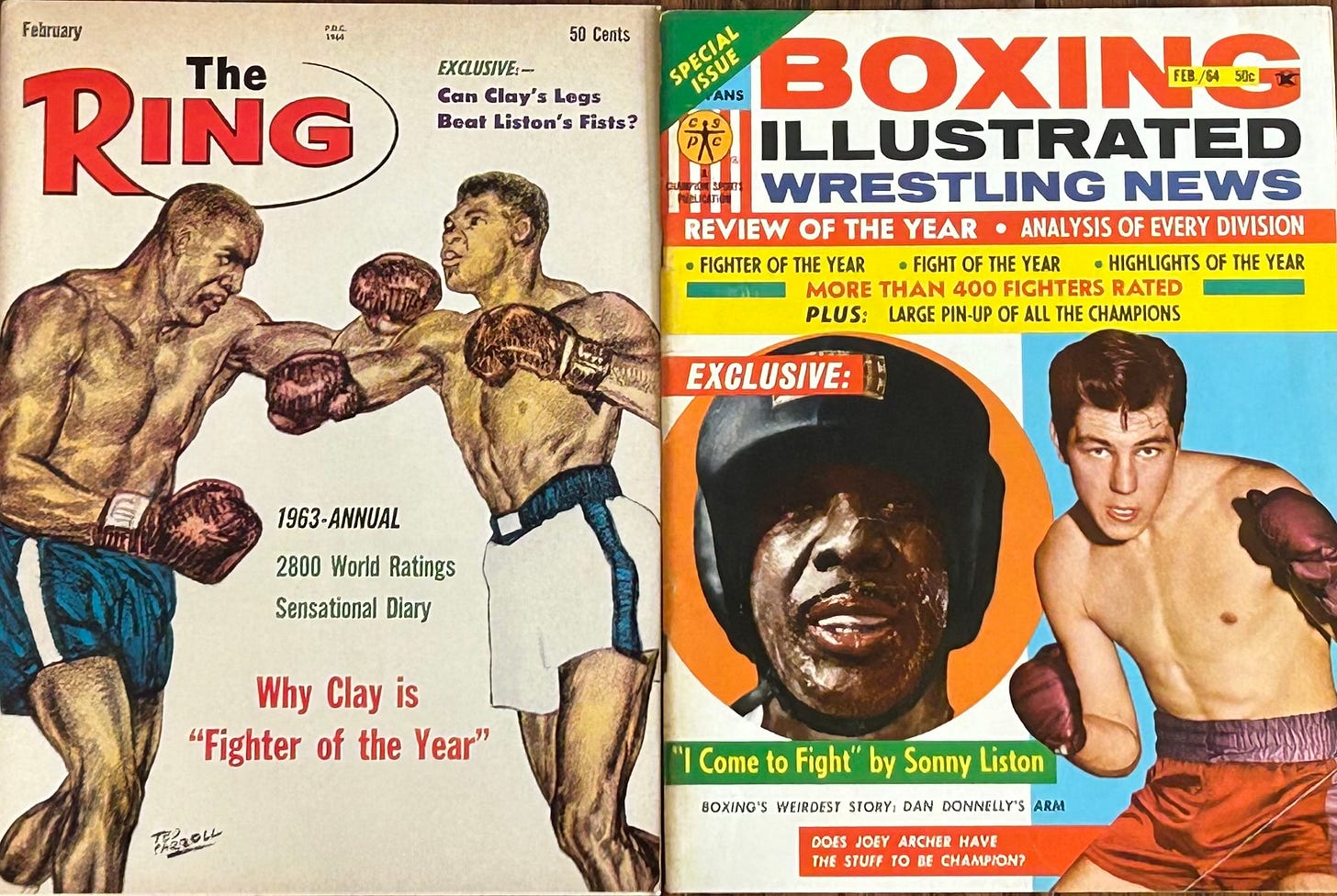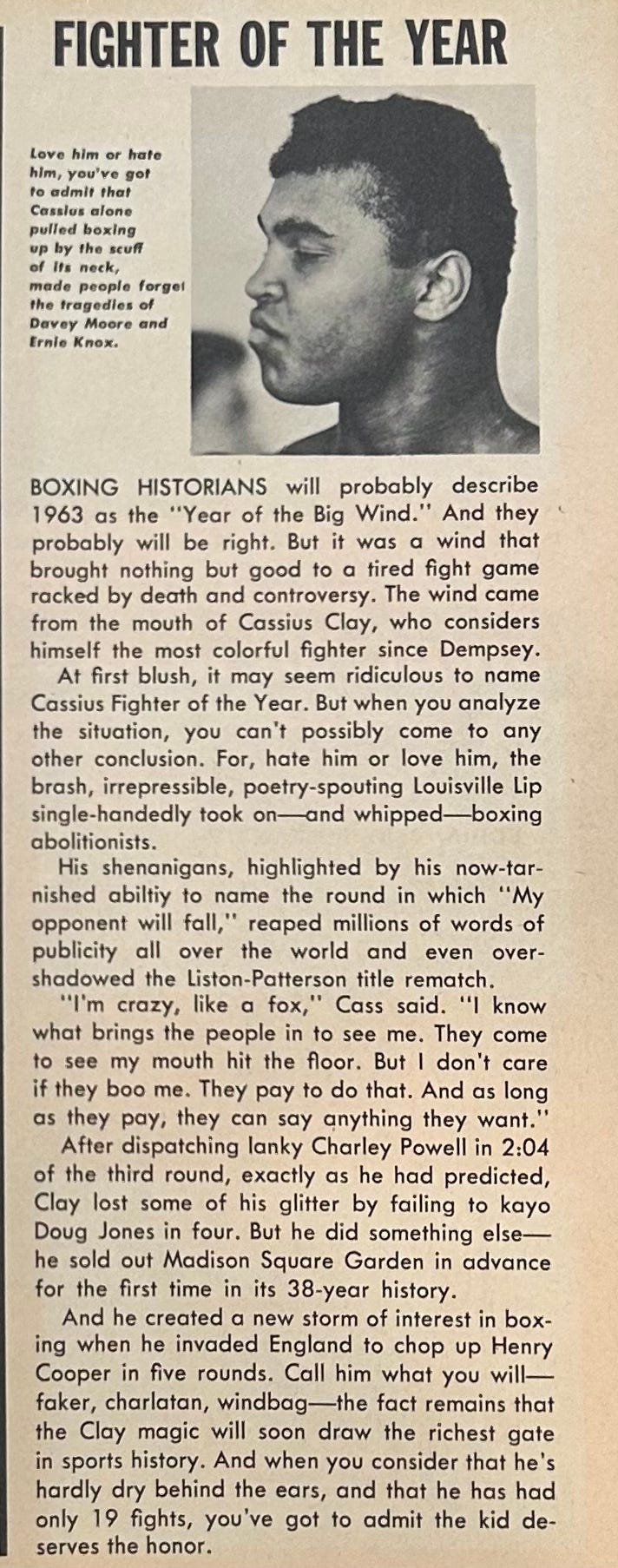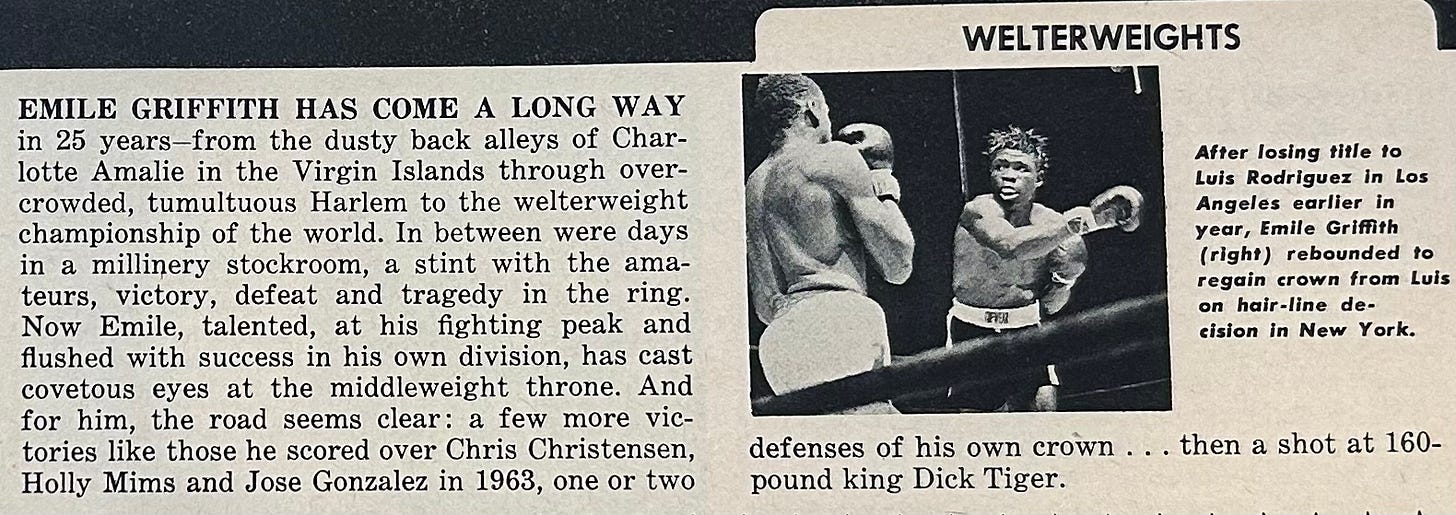Who Got it Right: Fight and Fighter of the Year 1963
Part two of an ongoing series taking readers from the 60s to today
For 1962, The Ring and the BWAA were in agreement for Fighter of the Year, selecting NBA middleweight champion Dick Tiger. As was the case following boxing’s 1961 campaign, Boxing Illustrated offered no selections for fight or fighter of the year for 1962, instead opting for a deep dive year-in-review through each of the sport’s weight classes.
Tiger went 3-0 on the year, opening 1962 with a fifth-round stoppage of Florentino Fernandez. Tiger’s win came just five months after Fernandez ran NBA titlist Gene Fullmer to a split decision over fifteen. Tiger followed with a near-shutout of tough Henry Hank at Madison Square Garden before securing a crack at Fullmer in October. In front of nearly 12,000 fans at San Francisco’s Candlestick Park and additional masses on closed circuit television, Tiger won a unanimous decision for the crown.
Hank, mentioned above, also featured in Ring’s selection for Fight of the Year, losing a narrow ten-round decision in January 1962 to Joey Giardello.
It didn’t take long to arrive at our next debate in 1963, this time with splits for Fighter and Fight of the Year.
Boxing Illustrated expanded their year-in-review features, adding a page that provided choices in both categories, agreeing with The Ring on fighter honors but splitting distinctly in the fight category. The BWAA sided against the selection of both publications for the year’s premiere performer.
The choices to be debated for 1963 are:
Cassius Clay - Ring Magazine and Boxing Illustrated Fighter of the Year 1963
Emile Griffith - BWAA Fighter of the Year 1963
Clay-Doug Jones - Ring Magazine Fight of the Year 1963, and
Tiger-Fullmer II - Boxing Illustrated Fight of the Year 1963.
In selecting the still-rising heavyweight who was at press time was just weeks away from challenging Sonny Liston for the title, Dan Daniel noted for The Ring “the selection of Clay, on the basis of what he had achieved for himself and for boxing this past year, involved considerations which seldom had been weighed so carefully and so seriously in arriving at the annual designation…these considerations had to do with factors for the good and welfare of boxing which are not summed up altogether in the results of the fights.” (Cover Date Feb 1964, p. 12)
Daniel went on further to describe the context of the moment. The arrival of the man who would soon be known as Muhammad Ali on the boxing scene came at a moment when the sport needed a fresh personality following myriad controversies. His birth name is used in this article for historical accuracy in the context of the year being discussed.
Clay in 1963 became a celebrity as well as a fighter. He released a comedy album, graced the cover of Sports Illustrated for the first time, and went 3-0 on the year while continuing to predict the round where he would win his fights (with varying accuracy).
Boxing Illustrated was similarly impressed with Clay’s impact outside the ring (Cover Date Feb 1964, p. 39):
The voters of the BWAA were less influenced by the significance of new star power, opting for the selection of Emile Griffith. Griffith finished as second runner-up to Clay in The Ring, behind Liston and ahead of middleweight champion Joey Giardello, lightweight champion Carlos Ortiz, and bantamweight champion Eder Jofre. Griffith lost and regained the welterweight crown in 1963 while posting a mark of 4-2 on the year.
(Boxing Illustrated, Cover Date Feb 1964, p. 29)
Let’s take a deeper dive into the case for both Clay and Griffith.
The Case for Clay: After going 6-0 the prior year, Clay’s activity slowed while his star rose. His 3-0 run on the year included a pair of memorable contests that could easily have derailed his quest for Liston. Heading into the three fights, here’s where The Ring and Boxing Illustrated ranked his opponents during the year:
KO3 Charlie Powell (Unranked)
UD10 Doug Jones (Ring #3, Cover Date: 04/63; BI #4, CD: 05/63 - Hvy)
TKO5 Henry Cooper (Ring #9, CD: 07/63; BI #6, CD: 08/63 - Hvy)
The Jones fight was a narrow escape with Clay receiving scores of 5-4-1 from two of the judges. Many young greats have an early fight that could have gone the other way. For Clay, Jones was his.
Some might argue Cooper was as well. Famously dropped hard at the end of round four, a tear in Clay’s glove that legend says was manipulated by trainer Angelo Dundee bought precious extra seconds for Clay to clear his head. When he did, his attack left Cooper a bloody mess and brought an end to the contest in round five.
The Cooper win moved the 1960 Olympic light heavyweight gold medalist to 19-0 with the above mentioned sellout of the Garden and some 35,000 on hand at Wembley Stadium for Cooper. A star was born and the deck was cleared for a crack at the title.
The Case for Griffith: Griffith had twice as many fights as Clay during the year, posting a mark of 4-2 across three countries and three weight classes. He opened the year defending a lightly regarded claim to the light middleweight title, a division still in its infant days. More impressively, he lost and regained the welterweight crown against one of his greatest rivals in the second and third bouts of their four-fight rivalry.
Griffith’s opponent rankings for the year were:
TKO9 Chris Christensen (Unranked - 154)
L15 Luis Rodriguez (Ring #1, CD: 04/63; BI #1, CD: 05/63 - 147)
SD15 Luis Rodriguez (World Welterweight Champion)
UD10 Holly Mims (Unranked - 160)
MD10 Jose Gonzalez (Ring #8, CD: 10/63; BI #6, CD: 11/63 - 160)
TKO by 1 Rubin Carter (Ring #8, CD: 01/64; BI #3, CD: 02/64)
Griffith danced close to peril consistently during the year. His win over Rodriguez to secure the welterweight title for the third time was widely debated by ringside press at the time and he overcame an odd draw scorecard in a Gonzalez fight most saw him winning wide. The Carter loss to end the year was a stunner, one of only two career knockout losses for Griffith.
He was well traveled from start to finish, facing Christensen in Denmark, Rodriguez in front of some 20,000 at Dodger Stadium and then again in a surprisingly sparse crowd of just more than 8,000 at the Garden, and Gonzalez in Puerto Rico.
Before resolving which fighter had the better case as top man of the year, let’s move on to the year’s best fight.
The Case for Clay-Jones: Regardless of how one felt about the decision, there was no denying the box office bonanza or its implications on the big picture of boxing’s flagship weight class.
Describing the choice of Clay-Jones, Nat Loubet wrote, “In designating the Clay-Jones affair as the Fight of the Year, the Ring Magazine did not pick hot as the most sanguinary scrap of the twelve months. However, it was a splendid fight and it caused a lot of controversy, many of the fans who packed the Garden in a no-televsion test coming away with the impression that the winner had been declared the loser.” (The Ring, Cover Date Feb 1964, p.6)
The general consensus was that, if he deserved the win, Clay pulled off with a surge in the closing rounds. While there may not have been live television, the fight is widely available to view today. It’s an interesting, exciting technical clash pitting a phenomenal new talent against a skilled veteran who had fallen short the year before in challenging light heavyweight champion Harold Johnson.
No one voting then could know just how significant the narrow win would be to the unfolding of the most storied of all careers.
The Case for Tiger-Fullmer II: The Ring listed multiple runners-up to Clay-Jones for Fight of the Year and included a Tiger-Fullmer fight…just not this one. The Ring saluted the third and final fight in the series.
Boxing Illustrated went with the middle chapter of their violent series.
(Boxing Illustrated, Cover Date Feb 1964, p. 39)
After a demonstrative victory to take the title in their first clash, Tiger and Fullmer headed to Vegas to do it again and produced a far different affair. Unfortunately for this review, while a copy of Clay-Jones was available to view, the second Fullmer-Tiger fight was not so the descriptions of the fight will have to suffice.
Fullmer reportedly made adjustments from the first fight, boxing and frustrating Tiger before willing himself through blood and pain as the fight progressed. Tiger was cut too, and behind late only to close strong to retain his crown. While he didn’t do enough to regain the title, it was a last noble stand for Fullmer just four months after having the hell beaten out of him in their first fight.
The rubber match later in the year closed the door on Fullmer’s career with a corner retirement after seven. It was only the second stoppage loss of his career.
So the cases for both fight and fighter are laid out. For 1963, we ask one more time…
Who Got it Right?
Starting with the Fight selection, it’s understandable The Ring would have been enamored with the Clay-Jones affair. The New York-based publication knew a star when it saw one and could feel it first hand at the Garden. While there would be much better fights later featuring Ali, it’s certainly an exciting affair with a lively crowd.
The lack of film for Tiger-Fullmer II hurts but the nature of the fighters can’t be discounted. Fans in Las Vegas were treated to fifteen rounds of Tiger and Fullmer, a pair of Hall of Fame middleweight greats beating each other bloody with no one able to figure out a winner at the end.
Add to that this being the last great war in a career full of them for Fullmer and the educated guess here is Boxing Illustrated had the stronger choice for Fight of the Year.
The choice for Fighter of the Year is decidedly against the BWAA. 1963 saw the emergence of arguably the greatest global star boxing ever saw on the global stage. Cassius Clay may have had luck on his side but his 3-0 run gave the sport a new superstar at a time when it needed one, selling masses of tickets on two continents. That no one could know just how bright that star would shine mattered little. He beat two quality contenders and made himself next in line for the fearsome Liston.
Griffith, a truly great fighter, had a fine year. While there are those who would argue he never genuinely beat Rodriguez, he got the verdict and did accomplish the impressive feat of capturing the welterweight crown for the third time. Closing the year with a first-round knockout loss can’t be ignore though and is a worse outcome than surviving some scares.
Cassius Clay was the right choice for Fighter of the Year.








